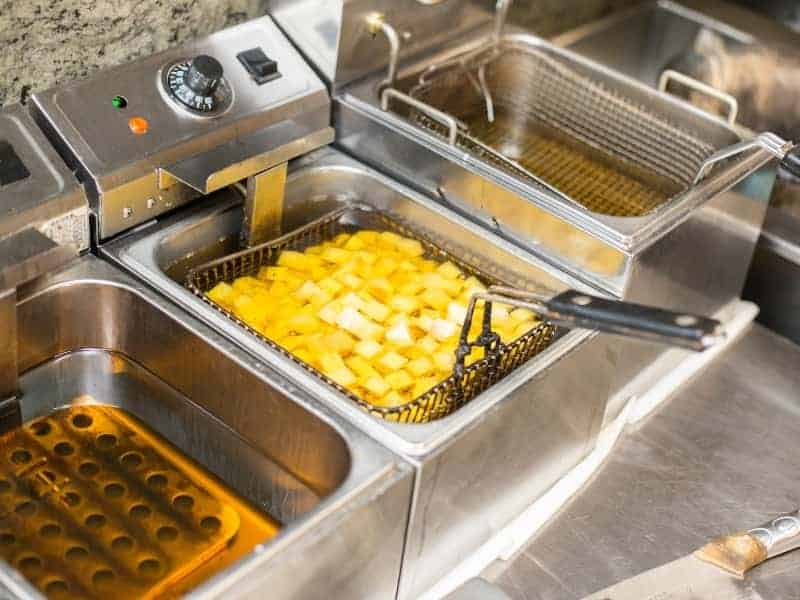Vegetable oil and lard are two of the most common fats used in cooking and baking, but which one is better?
Let’s delve into the differences between vegetable oil and lard, explore their best uses in the kitchen, compare their nutritional values, and ultimately decide which is the better choice for your needs!
Lard is just as versatile as any other cooking fat and can be used for roasting, grilling, sauteeing, frying, and baking. In its solid form it can be used just like butter or shortening and added to baking recipes. Use a small amount to grease a pan, or add it by the cup full to your cast-iron skillet for deep frying.

Today lard is seen as a dangerous fat… but is it? Find out the facts here.
Lard is sustainable! If you use lard to cook, you use more of the animal thus wasting less and being more environmentally conscious. So when cooking any type of pork that contains a lot of fat, make sure to cook it slow and save the fatty drippings for future cooking!
Lard contains about one third as much cholesterol as butter… that’s 12mg per tbsp vs. 31mg per tbsp. Our bodies need fat to absorb the fat-soluble vitamins, A, D, E and K. Without dietary fats, our bodies have a hard time absorbing these critical vitamins. Necessary for immunity and general health.
Lard is an extremely versatile fat: It doesnt smoke at high temperatures, so its perfect for high heat cooking or frying. This also means it doesn’t break down and oxidize, creating harmful free radicals (the reason you don’t cook extra virgin olive oil at high temperatures).
Choose lard from pasture-raised pigs. The fat composition of lard rendered from pigs on pasture is better for you than lard from pigs raised in industrial confinement. And if you can, render the lard at home – as commercial lard is bleached and deodorized – and sometimes has actually been hydrogenated to make it last longer (aka trans fats are added!).
Nutrition: Vegetable oil vs lard
Vegetable oil is generally considered healthier than lard due to its higher polyunsaturated fat content, including essential omega-6 fatty acids.
Lard, derived from animal fat, is higher in monounsaturated and saturated fats. While monounsaturated fats in lard are beneficial, excessive saturated fat intake can raise cholesterol levels and increase the risk of heart disease.
Vegetable oils, low in saturated fats, offer potential health benefits, such as reducing inflammation and promoting heart health. However, it’s important to maintain a balance between omega-6 and omega-3 fatty acids. Overall, moderation and a well-rounded diet are key!
Below is a comparison of the nutritional facts of vegetable oil vs lard. Please note that the specific nutritional values may vary slightly depending on the brand and type of oil or lard used.
| Per tablespoon (15mL) | Vegetable oil | Lard (Pork fat) |
| Calories | 120 | 115 |
| Polyunsaturated | 7.8 g | 1.4 g |
| Monounsaturated | 3.1 g | 5.8 g |
| Saturated | 2.1 g | 5 g |
| Trans | 0.1 g | 0 g |
| Total Fat | 13.6 g | 12.8 g |
| Cholesterol | 0 | 12 mg |
The primary fat source is bolded.
Lard vs Vegetable Oil: Which is Healthier?
FAQ
Is deep frying with lard healthy?
Can I use lard in place of vegetable oil?
Can I reuse lard for deep frying?
What is the best thing to fry in lard?
Can you use lard instead of vegetable oil for frying?
Yes, you can use lard instead of vegetable oil for frying. Lard is a good choice for frying because it has a high smoke point and doesn’t contain unhealthy trans fats like vegetable oil does. However, it’s important to choose pure lard and not the hydrogenated kind, which contains harmful trans fats. Is it healthy to deep fry in lard?
Is frying with olive oil ok?
Yes, olive oil and extra virgin olive oil have a smoke point of 190-207 degrees Celsius. This higher smoke point makes olive oil safe for frying without potentially creating harmful smoke and carcinogens.
Is lard a good oil for frying?
Lard is rendered pig fat. After tallow, we consider larding the next best oil for deep frying and shallow frying. Lard consists of 39% Saturated fat, 45% monounsaturated fat, and 11% polyunsaturated fat. It has a high smoke point of 374°F/190°C slightly less than Tallow. Can I use lard instead of oil for frying?
Can you use lard & plant based oil in deep frying?
You can definitely do so when deep frying foods. The main reason people opt for a blend of lard and plant-based oils is to cut back on costs. As I’ve mentioned, lard is quite expensive and for deep frying, you need a lot. That being said, keep in mind that blending the oils reduces their effectiveness and nutritional benefits.
